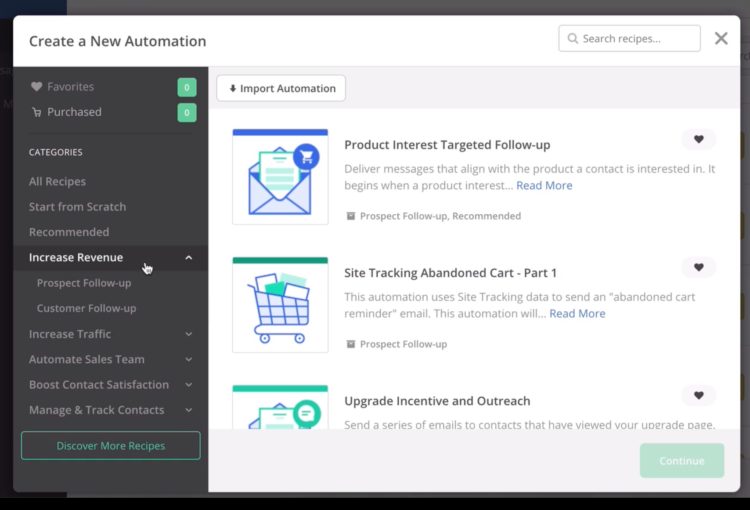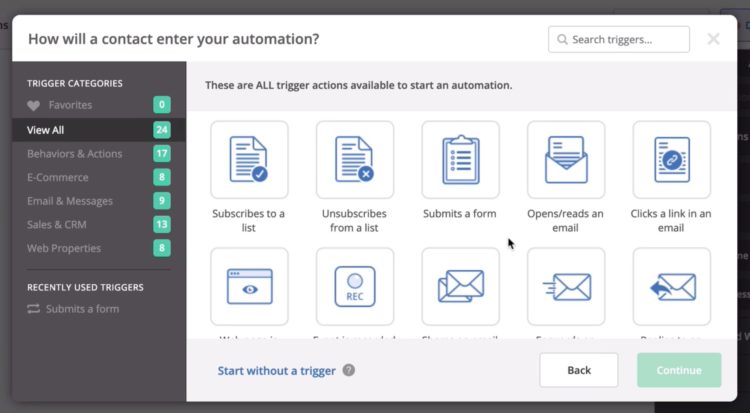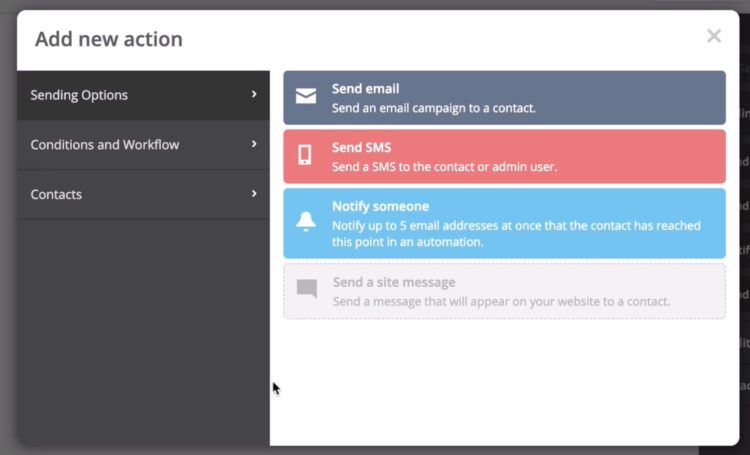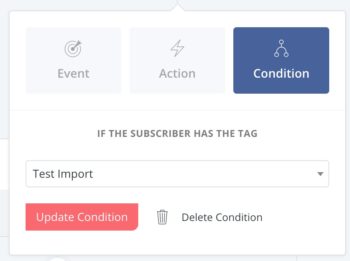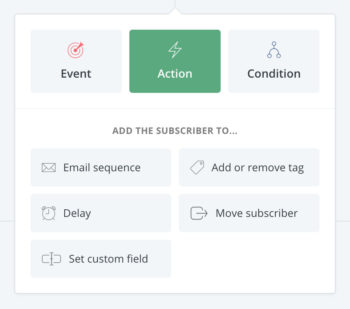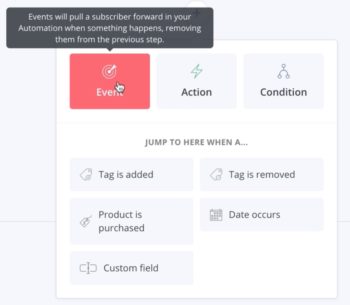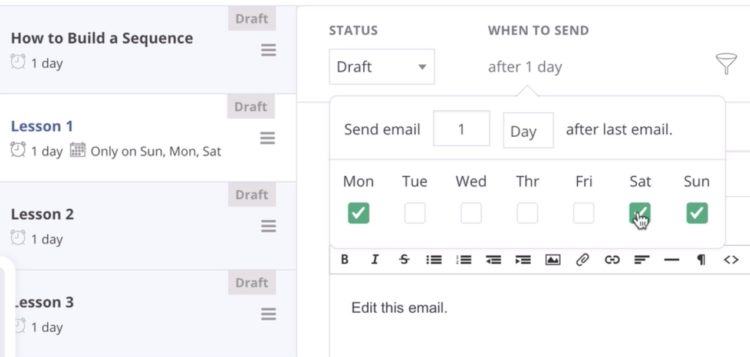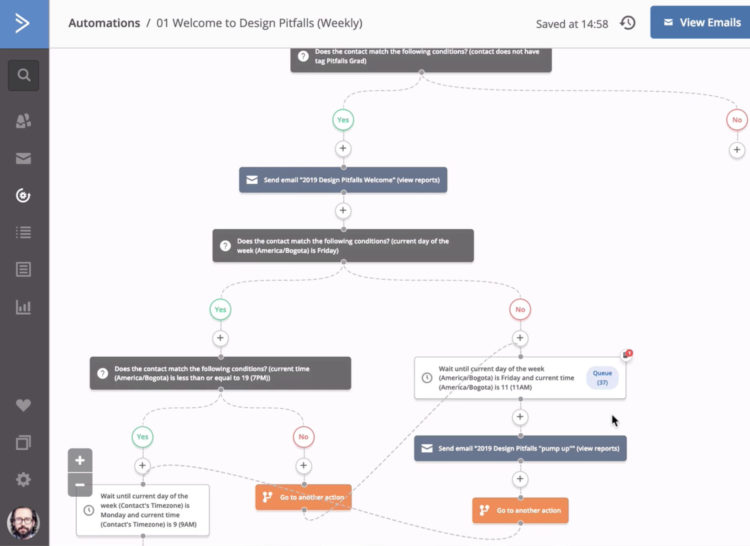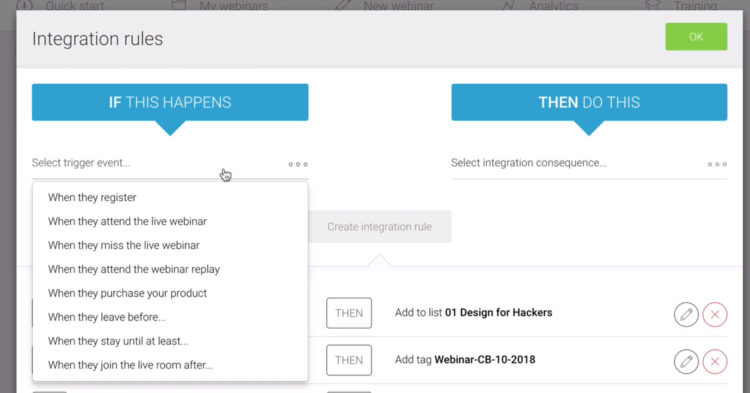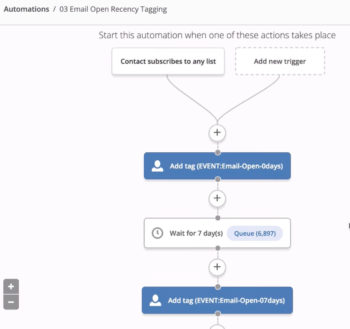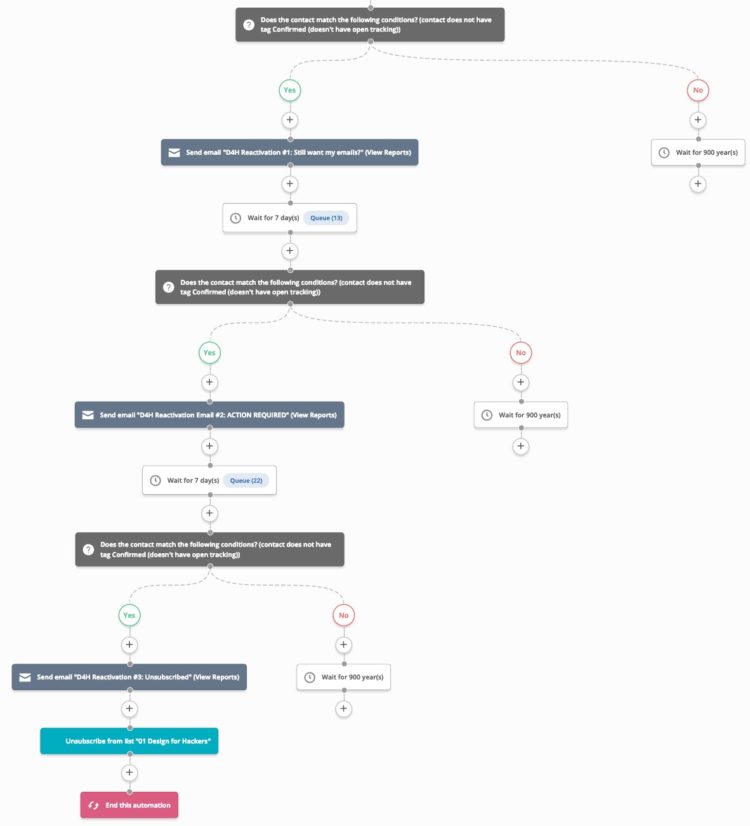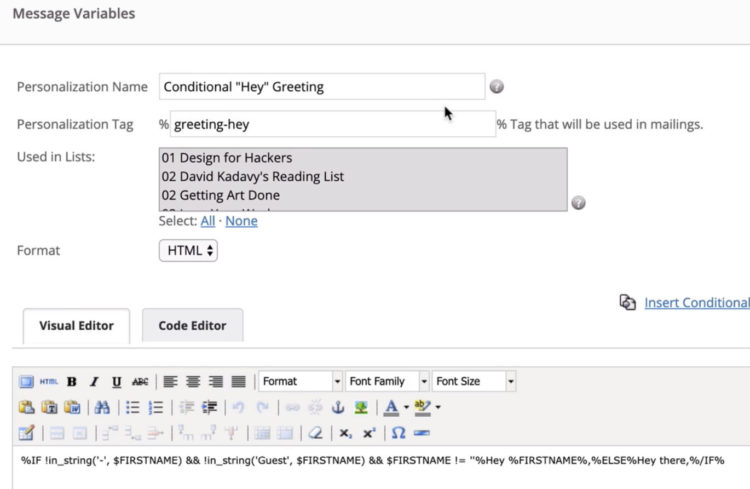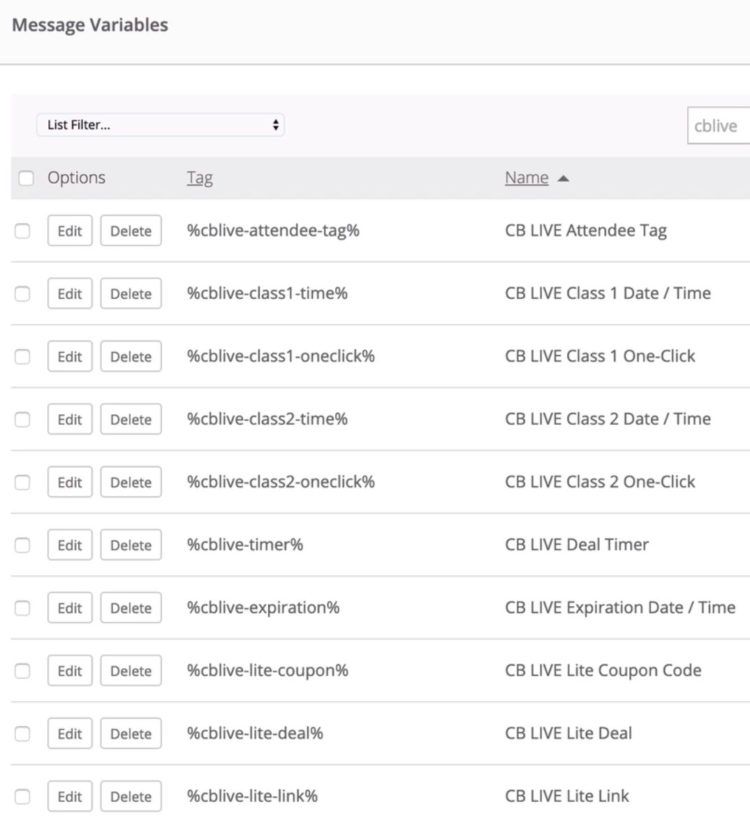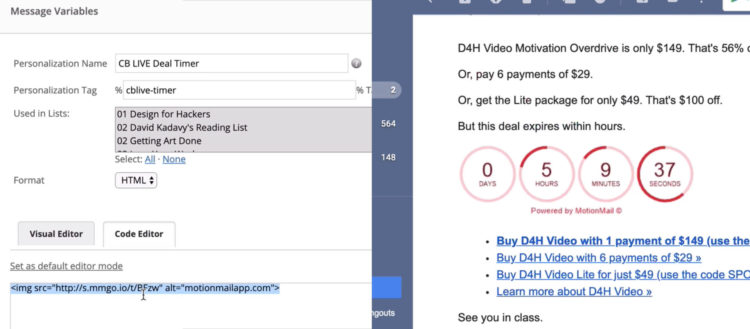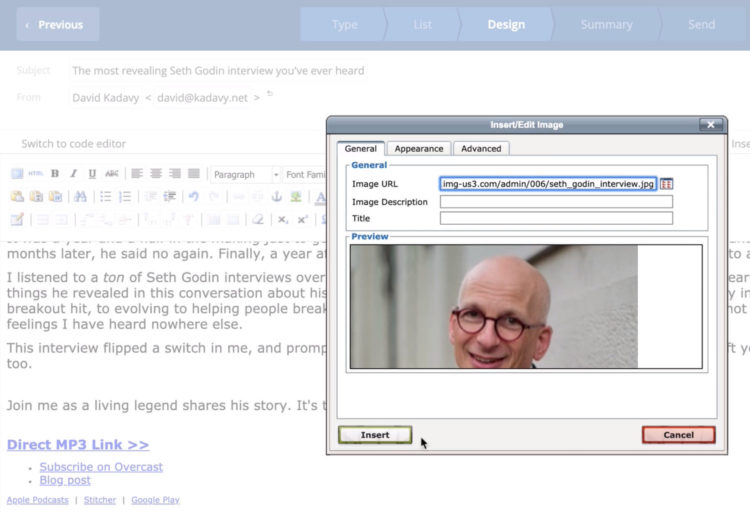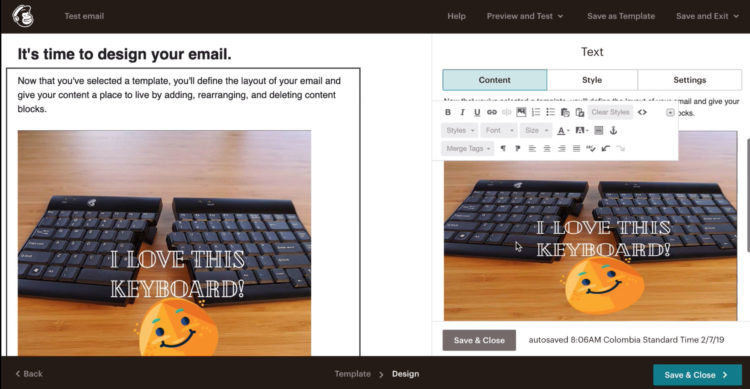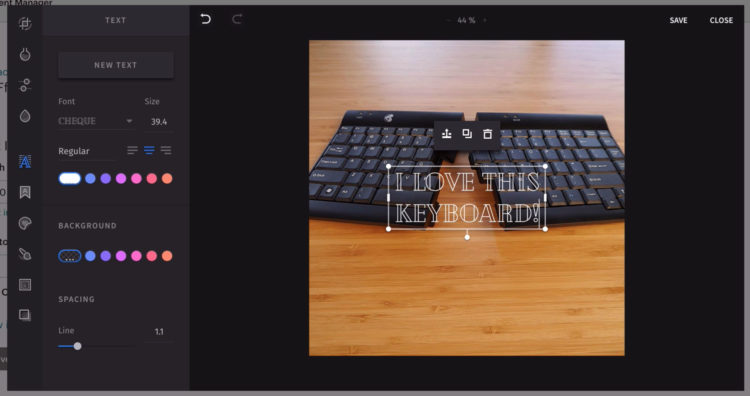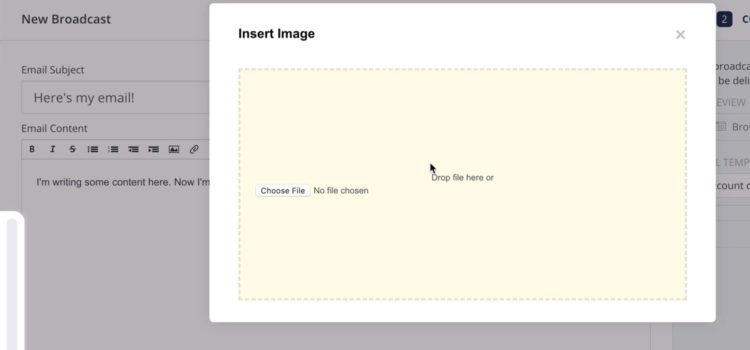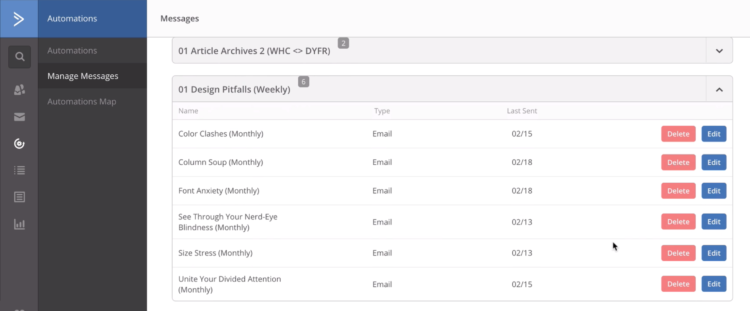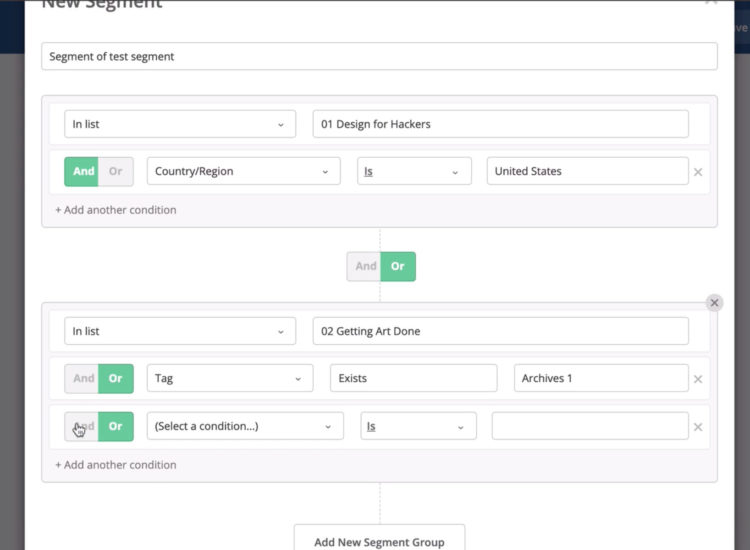Subscribe to blog updates via email »
ActiveCampaign Review
 After years of research, several years ago I switched from MailChimp to ActiveCampaign. Why do I love ActiveCampaign so much? I’ve already done my MailChimp vs. ActiveCampaign comparison. Now it’s time to do an ActiveCampaign review.
After years of research, several years ago I switched from MailChimp to ActiveCampaign. Why do I love ActiveCampaign so much? I’ve already done my MailChimp vs. ActiveCampaign comparison. Now it’s time to do an ActiveCampaign review.
This review is also available as a video, and on your favorite e-reader.
ActiveCampaign 14-day free trial
If at any point you decide ActiveCampaign is right for you, I have an ActiveCampaign 14-day free trial coupon available at this link. If you use my link, you get this free trial, and I get a commission at no extra cost to you. It’s a great way to thank me for this review, and to make it possible for me to make more reviews like this one.
ActiveCampaign “Pros”
Here’s what I love about ActiveCampaign, along with why that fits my business. I’ll expand on all of these later:
- You can do just about anything with ActiveCampaign. My personality is such that I want to dream up the right way to do my email marketing, and then I want to build exactly that. I can always do that with ActiveCampaign. I personally struggle being limited by a tool. But some people are good at that. MailChimp was extremely limited, and that didn’t fit me and my business.
- ActiveCampaign’s automations are easy to understand and visualize. This is because they have a visual, drag-and-drop editor. They were the first service I came across that had a drag-and-drop editor, besides InfusionSoft – which I wanted to avoid because everyone was calling it “confusionsoft.” The moment I saw ActiveCampaign’s automation builder, I was in love. Many other services have visual editors now, and I’m not sure which ones were simply following ActiveCampaign’s lead.
- ActiveCampaign has versatile goal tracking. You’re probably doing email marketing because you have some goal you want to meet with your prospects. With ActiveCampaign, you can track the success of your efforts with goal tracking. Because you can do just about anything with ActiveCampaign, your goal can be just about anything – whether that’s registering for a webinar, or buying a product.
- ActiveCampaign has tons of integrations. When I started with ActiveCampaign, they were up and coming. Now they’re one of the top email marketing platforms, so they have more integrations than ever. And those integrations tend to be rich, giving a lot of control.
- ActiveCampaign has Message Variables. This is my favorite ActiveCampaign feature. You can create a library of plain text or HTML snippets that you can then reuse throughout your campaigns. For example, if you want to change a coupon code in an automation on a regular basis, you can do that.
- ActiveCampaign has the best deliverability in the business. This wasn’t readily apparent to me. I do think MailChimp had good deliverability, and I once had a deliverability issue with ActiveCampaign (that support quickly straightened out for me). But according to a recent report by Email Tool Tester, ActiveCampaign leads the industry with a 97% deliverability rate. By contrast, MailChimp and ConvertKit have about 81% deliverability rates, and AWeber only a 75% deliverability rate.
- ActiveCampaign has advanced tiers of service. Switching email marketing platforms is a pain, so you hate to have to switch simply because your business grows. With ActiveCampaign, you can upgrade to a “Pro”-level plan, which has additional features such as lead scoring, a CRM, SMS marketing, and on-site chat.
- ActiveCampaign has competitive pricing. I wouldn’t let a few bucks difference force me to pick a different email marketing platform, but ActiveCampaign’s pricing is a great deal.
ActiveCampaign “Cons”
No email marketing platform is perfect. Here are things that have bothered me about ActiveCampaign:
- Clunky email editing experience. I got spoiled with MailChimp’s email editor. It’s the easiest to use. ActiveCampaign’s email editor has some strange quirks that slow me down.
- Cumbersome to edit multiple emails in an automation. Editing emails in an automation is a pain in ActiveCampaign. ConvertKit is the best at this experience.
- You have to build everything from scratch. Many email marketing platforms have shortcuts for doing certain things, such as identifying inactive contacts, adjusting granular subscription preferences, or delivering lead magnets. But on ActiveCampaign, you have to build all of these from scratch, which steepens the learning curve.
- Occasional slow performance. When I first joined ActiveCampaign, performance was painfully slow. I think they were experiencing growing pains, as they’ve quickly grown to be a dominant email marketing platform. Performance has improved dramatically, but I still occasionally experience slow performance, mostly in viewing reports.
- The features can be overwhelming. Because you can do anything with ActiveCampaign, there are a lot of features to sort through. This makes the learning curve steep. If you aren’t willing to put in time to learn the ins and outs of ActiveCampaign, you may be better off with a more simple platform, such as MailChimp, or even ConvertKit is more simple.
My perspective as an ActiveCampaign reviewer
Now that I have the basic details out of the way, let me tell you about my perspective. This will help you see where you and your business might be different, and where you might have different preferences in your email marketing platform.
- I’m an author and podcaster. I build my list with lead magnets and email courses, and I regularly send original content. I never buy nor sell emails.
- I sell online courses. In addition to my books, I sell online courses direct to my audience. My payment processor is SendOwl, and ActiveCampaign integrates with them beautifully.
- I do webinars. I often sell my courses via live and evergreen webinars. My webinar platform is WebinarJam, and ActiveCampaign again integrates with them beautifully.
- I do occasional affiliate marketing. Some email marketing platforms frown upon affiliate marketing if you’re doing it really heavily. I do only occasional affiliate marketing, and I haven’t had any problems with ActiveCampaign.
Let’s take a look at some of the ways that I use ActiveCampaign in my business.
ActiveCampaign’s automations are versatile
ActiveCampaign has always been built to have automations. This is a contrast to some of the original email marketing platforms that have been around for much longer, such as MailChimp and AWeber.
AWeber and MailChimp both have automations, but they are limited. Limited automations was one of the main reasons I switched from MailChimp to ActiveCampaign. I believe that because ActiveCampaign has always had automations, that is part of why they are so good at automations.
Automations enable you to automatically send emails to contacts based upon a variety of factors, such as when they signed up, and how much they are interacting with your emails.
Let’s take a look at some of the building blocks of ActiveCampaign’s automations.
ActiveCampaign’s automation library
ActiveCampaign has a library full of pre-built automations. You can build automations to:
- Follow up with prospects
- Increase referral traffic
- Automate your sales team
- and more…
Building automations from scratch on ActiveCampaign
You can do just about anything with ActiveCampaign when you build automations from scratch.
There are a number of ways you can trigger an automation, including:
- When a tag is added
- When a contact subscribes to a list
- When a contact submits a form
- E-commerce and on-site options (available in the “Pro” plan)
- When the contact reaches a certain point in another automation. (Build this trigger from within the other automation.)
From there, you can start building the actions in your automation.
Some actions that are available in ActiveCampaign’s automations are:
- Send an email
- Notify a team member
- Wait conditions
- If/then conditionals
- Split traffic for testing
- Skip to other parts of the automation
- Track goals (The contact can skip to the goal’s place in the automation.)
- Start or end another automation, or end the current automation
- Post a webhook
- Subscribe or unsubscribe the contact to/from lists
- Update contact details
- Add and remove tags
- Add a note
- Lead scoring, SMS and site messages, and Facebook Custom Audience management are all “Pro” features.
Quick comparison: ActiveCampaign’s automations have more options than ConvertKit’s
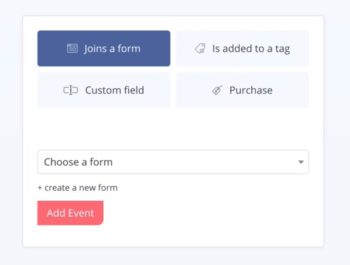
You can trigger a ConvertKit automation when a contact joins a form, is added to a tag, when a custom field changes, or after the contact makes a purchase.
Contrast with ConvertKit’s Automations, which are more limited. On ConvertKit, you can trigger an automation when:
- The contact submits a form
- The contact makes a purchase
- A tag is added to the contact
- A custom field is updated with a certain value
From there, you can create Conditions, to check whether the contact has a certain tag or custom field value.
You can also create Actions, such as:
- Delay progress in the automation
- Move the contact to another automation
- Start an email sequence
You can also create Events, which are a bit like ActiveCampaign’s Goals, but without the reporting. You can track an Event when:
- A tag is added or removed
- The contact makes a purchase
- A date occurs
- A custom field is updated with a certain value
You don’t create emails in ConvertKit’s Automations. Instead, you send your contact into a Sequence, which is a series of emails sent according to the schedule and conditions you create.
For more on how ActiveCampaign compares to ConvertKit, read my ConvertKit vs ActiveCampaign comparison.
Building an email course with ActiveCampaign’s automations
The primary way I build my Design for Hackers list is through an email course. ActiveCampaign makes it easy for me to build my email course exactly how I’d like to build it.
Many marketers build very simple email sequences for their “email courses.” A contact signs up, and then that contact immediately starts getting lessons.
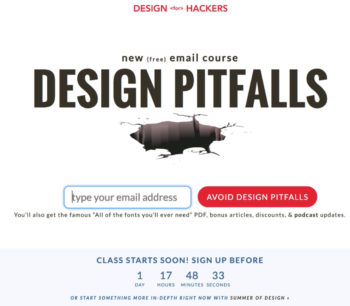
My weekly email course is synced (manually) with this timer on my site. It was easy to build with ActiveCampaign, but impossible when I was with MailChimp.
I don’t do that method. My email course is manually synced with this countdown timer on my site.
You have to sign up by Friday night, and a new course begins each Monday morning.
When I first tried this methodology, I was on MailChimp. I had to manually start my email course each week, because that was the only way to do it the way I wanted at the time.
Here’s the automation I use to welcome new students to my Design Pitfalls course.
There’s a few things going on here:
- The automation sends all contacts a “welcome email.”
- The automation verifies that it’s not Friday.
- If it’s not Friday, the automation waits until it is Friday. At 11am, it sends a “pump up” email to get the students ready for next week’s course, and encourage them to share it with friends.
- If it is Friday and before 7pm, the automation skips the “pump up” email. The contact will start getting lessons the following Monday morning.
If it is Friday and after 7pm, the contact missed enrollment for next week’s class. They’ll get the pump up email the following Friday morning, and lessons the Monday after that.
It was impossible for me to automate this with MailChimp. With ActiveCampaign, it’s relatively easy.
Automating a webinar with ActiveCampaign’s automations
When I run a webinar, I don’t want to send the same email to every person on my list. I want to send them the appropriate email for their level of engagement.
Here’s the automation I use to promote an evergreen webinar:
- First it verifies that they haven’t already purchased the product I pitch in the webinar. If they have, they get added to an automation for a different product.
- Then it sends a series of emails to get them interested in the webinar, and to encourage them to sign up.
- If they sign up, they immediately hit the “Goal” toward the end of the webinar, and the automation ends.
- If they don’t sign up, they get added to an automation promoting a rebroadcast of the webinar.
I’m able to tell whether the contact signed up because ActiveCampaign integrates very well with my webinar platform, WebinarJam. This enables me to customize my messaging, in other automations, based upon the contact’s engagement with the webinar. Here’s the WebinarJam integration panel:
I can add tags based upon whether the contact registered, attended, missed, or based upon how long they stayed in the webinar. These tags can then trigger automations within ActiveCampaign.
Monitoring engagement with ActiveCampaign’s Automations
If a contact isn’t opening my emails, I don’t want to be sending them emails. It costs me money, and it makes it more likely that my emails go to spam or Gmail’s promotions tab. People who don’t open my emails make it harder for other emails to get to the people who really want them!
The “Pro” plan of ActiveCampaign has lead scoring built in. But even on the “Lite” plan, you can roll your own automations to tell how engaged subscribers are.
Here’s an automation I got from ActiveCampaign’s library of automations, which I use to tell which contacts aren’t engaging with my emails.
- When a contact subscribes, this automation adds a “0 days” tag.
- As time passes, it adds new tags for 7 days, 30 days, 60 days, etc
- Each time they open an email, a separate automation removes them from this automation, removes all of those tags, and starts this automation over again.
Any time one of these tags is added, I can use it to trigger a “reactivation” campaign, which I’ll talk about in a bit.
This automation can be overwhelming at first, and this is one of those cases where I wish ActiveCampaign had a more out-of-the-box solution. But, because you can do anything with ActiveCampaign, sometimes you have to build things from scratch.
Automating reactivation campaigns with ActiveCampaign
ActiveCampaign has an option to delete inactive subscribers, which I don’t recommend. You should at least run a reactivation campaign first.
Some subscribers don’t have tracking turned on, so their opens aren’t recorded. Others still want to be subscribed but have been busy.
Here’s my reactivation sequence:
- I send one email asking if they still want to be subscribed, and briefly explaining why I keep my email list clean.
- In one week, I send them another email (if they already clicked on the confirmation link in the previous email, they’ve already been removed from the automation – using a separate automation).
- After another week, I send them an email letting them know they’ve been unsubscribed, why, and how they can resubscribe in the future. The automation then unsubscribes them.
My emails also have a link to a form where they can enter their email address to let me know that they don’t have tracking enabled.
This form adds a tag that I use to filter those contacts out. I used to add this tag when they clicked on a link, but when people don’t have tracking on, it makes those links not work so reliably!
I only send a simple “do you still want my emails?” confirmation. There are even better ways to run a reactivation campaign. You can send bonus content and try to get the contact more engaged again.
Tracking Goals in ActiveCampaign’s automations
To know how well your automations are converting, ActiveCampaign has Goal tracking. A common way to measure whether a Goal has been met is if a tag has been added to the contact.
This tag can be added because your payment processor recorded a sale, or because your webinar platform recorded that your contact attended a webinar.
On the Goal report, you can see what percentage of contacts complete this goal, based upon the number of contacts who enter that automation. You can also see whether the completion rate has increased or decreased, how long it takes for contacts to reach that goal, and you can browse all contacts to see who did and didn’t reach the goal.
My favorite ActiveCampaign feature: Message Variables
ActiveCampaign’s Message Variables is my favorite feature. It saves me a ton of time and effort, and neither MailChimp nor ConvertKit (update: 9/2020 ConvertKit now has “snippets”) has a comparable feature. AWeber has something similar with its Global Text Snippets, but they are very basic.
Custom greeting with ActiveCampaign’s message variables
Let’s say you have the first name of only some of your contacts, which is the case with my list. I usually don’t require a first name to sign up to my list, but sometimes I get a first name, such as when someone buys a product.
Wouldn’t it be nice to greet your contacts by name, in the cases when you have it? You can do this, but it’s cumbersome.
In this text, I’m checking to see whether the contact has a first name in the database. I’m also filtering for generic terms added by other systems, such as a dash, or “Guest.” If they have a first name, I say “Hey,” and then their first name. If they don’t, I just say “Hey there,”.

By building a Message Variable in ActiveCampaign, I can easily change my greeting according to whether or not I have the contact’s first name.
With Message Variables, I don’t have to type that every single time. I created a variable that’s simply %greeting-hey%. If I have the contact’s name, it shows up in the email. If I don’t have the contact’s name, it defaults to “Hey,”.
Easy webinar customization with ActiveCampaign’s Message Variables
Where Message Variables really save me a lot of time is by enabling me use the same automation over and over again for my webinars, and I can quickly change out all of the details.
Here are variables for a webinar I run called “Bust Through Creative Blocks.” You can see I have a bunch of different variables here, such as the date and time of the webinar, the price of the product, deal terms, coupon code, and more.
Each time I run a new webinar, I can change each of these variables to match any schedule changes or offer changes.
For example, here’s the variable for my Motion Mail deadline timer. And here it is in an email.
ActiveCampaign’s email editing experience is sub-par
I did mention earlier that one of the cons of ActiveCampaign is their email editing experience. I switched from MailChimp, and MailChimp happens to have the best email editing experience.
I really like to send simple emails. Just basic text like it was an email from a friend. I’ve found that very hard to do with ActiveCampaign.
For a long time, I used ActiveCampaign’s hybrid HTML and WYSIWYG editor, which was triggered by a basic template I created. The interface for the HTML editor looks like it was pulled from some free open-source project. But, it does enable you to create an email with as little or as much formatting as you’d like. However, adding images is a bit of a chore. You have to select them from a file browser. There’s no drag and drop option.
The alternative to this, if you want to have control over the HTML, is to edit pure HTML, with a preview on the side. But you can’t manipulate it visually, you have to strictly write in HTML.
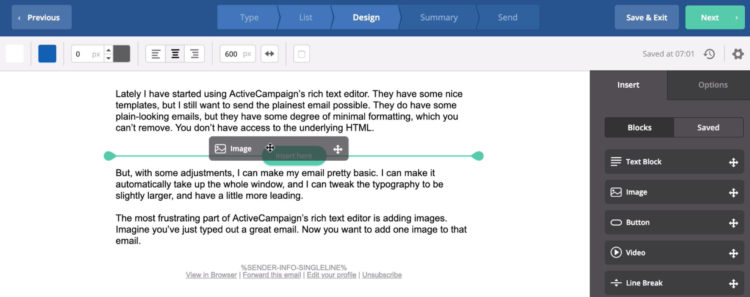
Adding images to ActiveCampaign’s rich text editor is a clunky experience. You need separate text boxes for above and below the image.
Lately I have started using ActiveCampaign’s rich text editor. They have some nice templates, but I still want to send the plainest email possible. They do have some plain-looking emails, but they have some degree of minimal formatting, which you can’t remove. You don’t have access to the underlying HTML.
But, with some adjustments, I can make my email pretty basic. I can make it automatically take up the whole window, and I can tweak the typography to be slightly larger, and have a little more leading.
The most frustrating part of ActiveCampaign’s rich text editor is adding images. Imagine you’ve just typed out a great email. Now you want to add one image to that email.
You can’t simply add an image to a block of text. Instead, you have to create two blocks of text: one for before the image, and one for after the image. If you’ve made any formatting changes, you’ll have to keep an eye on those to stay consistent.
That’s one thing to deal with when you want to add one image, but when you want to add several, it becomes a big chore.
The one saving grace over the HTML editor is that you can drag and drop images into the email. They even have a basic mage editor where you can crop the image.
Quick comparison: MailChimp’s email editing experience is the best
MailChimp’s editor is the best I’ve seen in all of the email marketing platforms I’ve tried.
You have access to the underlying code, so you can create a truly plain email, provided you make a basic template first. They don’t have a full-width option natively, but you can add an image into the text anywhere you like.
MailChimp’s built-in image editor is extremely powerful. You can resize, crop, and add custom text to your images.
I miss MailChimp’s email-editing experience. It would save me a little time to have that same experience on ActiveCampaign. But the highly-customizable automations I can build on ActiveCampaign more than make up for that potential time savings.
Quick comparison: ConvertKit’s email editing makes plain emails easy
ConvertKit’s email editing experience is a happy medium between ActiveCampaign and MailChimp.
Their templates are limited, which is fine with me, but their email editing experience is slightly easier in that you can create inline images, and you can create a totally plain email, and even edit the underlying HTML.
ActiveCampaign “con:” Editing multiple emails in an automation
If you want to make some quick edits to some emails in an automation, with ActiveCampaign, it’s cumbersome.
Let’s say I’m working on an email course, and I want to quickly edit the first few lines of each email. I’ll click on an email, and it takes me to the editor for that email. Note that I can’t even Command + Click to open it in another tab. Whether they meant to or not, ActiveCampaign has disabled Command + Click from the automation editor.
If I wanted to switch back and forth between various emails, I would intuitively be inclined open the same automation in various tabs, then open the respective emails from each of those tabs.
But, it turns out ActiveCampaign does have an easier place to manage your automation messages. In the Automations section, there’s a “Manage Messages” area.
From here, you can see all of the messages in each of your automations. You can edit each one, or you can Command + Click to open each in a new tab to more easily edit your entire sequence.
Quick comparison: ConvertKit makes it easy to edit multiple emails in a sequence
Contrast that with ConvertKit’s Sequences. I can switch from editing one email to the next, and back, instantly.
Again, it would save me a lot of time to have ConvertKit’s automation email editing experience on ActiveCampaign. But choosing an email marketing platform is like choosing a spouse. ActiveCampaign makes up for it with their Message Variables, more robust automations, and advanced segmentation.
ActiveCampaign has very sophisticated segmentation options
Speaking of segmentation, another reason I switched from MailChimp to ActiveCampaign was that MailChimp has limited segmentation options.
ActiveCampaign’s, by contrast, are robust. You can combine attributes with an AND/OR operator, and you can mix and match those groups of traits with another AND/OR operator.
With MailChimp, you can only segment by AND/OR, however MailChimp’s Pro plan allows more sophisticated segmenting, for an additional $199 a month.
ActiveCampaign alternatives
In my search for the perfect email marketing platform, I saw many others, some of which I’ve already mentioned. Here’s how I compare ActiveCampaign to some of the leading alternatives.
ConvertKit. If I weren’t on ActiveCampaign, I would probably be using ConvertKit. Their automations are much easier to build, though they aren’t as versatile as ActiveCampaign’s, and their segmentations options aren’t as sophisticated either. They also don’t have goal tracking, or Message Variables.
Get a ConvertKit 14-day free trial »
MailChimp. You already know that I switched from MailChimp to ActiveCampaign. If you primarily want to do basic email blasts, if really attractive templates are important to you, and you can live with only very basic automations, you might like MailChimp. MailChimp is free for up to 2,000 contacts, though if you’re serious I’d strongly caution against locking yourself into an email marketing platform just because it’s cheaper on the short term. Switching is a pain, and it may cost you more in the long run.
Get up to 2,000 contacts free with MailChimp »
AWeber. AWeber has been around forever, so they integrate with anything. There’s no one particular thing that is special about AWeber. It has just-okay email editing experience, templates, and automations. One edge it has, in my opinion, is Global Text Snippets. I go more in depth in my AWeber Review. If you’re a small business with 5,000 subscribers or more, and you don’t need much more than basic broadcasts and automations, AWeber may be a good choice. Their pricing is very competitive above 5,000 subscribers.
Get a 30-day free trial with AWeber »
ActiveCampaign’s pricing is competitive
I generally don’t believe pricing should be a major factor in deciding the right email marketing platform for your business. Having the right features for your marketing strategy will ultimately make up for whatever price differences you find.
But, price is still a factor, so let’s look at pricing for ActiveCampaign vs. ActiveCampaign’s alternatives.
ActiveCampaign Alternatives Pricing
| # of Subscribers | 500 | 1,000 | 5,000 | 10,000 | 25,000 |
|---|---|---|---|---|---|
| ActiveCampaign (Lite) 14-day free trial » | $15 | $29 | $99 | $155 | $259 |
| AWeber 30-day free trial » | $19 | $29 | $49 | $69 | $149 |
| ConvertKit 14-day free trial » | $29 | $29 | $79 | $119 | $199 |
| MailChimp 2,000 contacts free » | FREE | FREE | $53 | $79 | $200 |
| All prices on per month basis. | |||||
As you can see:
- If you’re starting out with 500 contacts, ActiveCampaign’s Lite plan is cheaper than both AWeber and ConvertKit.
- ConvertKit is almost double the price of ActiveCampaign if you’re just starting out.
- MailChimp, is free below 2,000 contacts. But switching is a pain, so only choose MailChimp if it’s the best choice for you.
- But, at 5,000 contacts and above, ActiveCampaign is the most expensive. About 10% more than ConvertKit, and about 50% more than AWeber or MailChimp. As I’ve said, if you’re going to be making full use of ActiveCampaign’s rich automation features, it’s well worth the price difference.
Get a 14-day free trial of ActiveCampaign
In conclusion, ActiveCampaign is an incredibly versatile email marketing platform, and I’m so glad I took the time to do the research and make the switch from MailChimp to ActiveCampaign.
You can build just about anything with it, and the price is competitive. They have quickly become a dominant email marketing platform, and it’s well deserved.
If you try out ActiveCampaign, do me a favor. Sign up through my affiliate link at kadavy.net/ac
I’ll earn a commission if you use my link. You’ll get a 14-day free trial, it’s a good way to thank me for the detailed review, and you’ll help me write more reviews like this one.


